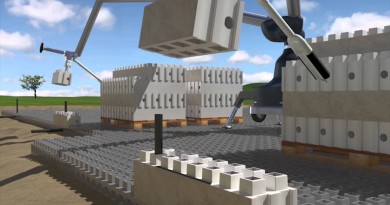Nanotechnology in the Construction Industry
Mention the word “nanotechnology” and people think of nanorobots. After all, that’s how Hollywood has portrayed it. Microscopic sized robots that crawl around accomplishing whatever nefarious task their creator programmed them to do. Mention nanotechnology in construction and they look at you strange, as if you’re a character from a science fiction movie.

Nevertheless, researchers are hard at work applying nanotechnology to the materials used in construction. While it sounds incredibly high tech, nanotechnology is actually just a type of materials science. By definition, it deals with materials that are less than 100 nanometers in length. To put that in perspective, the smallest thing the human eye can see is about 10,000 nanometers long.
Something interesting happens to materials at that size. Normal things like gravity don’t matter, and others, like electromagnetism function differently. Nanomaterials react differently with other materials than we’re used to, creating new compounds with surprising capabilities.
One of the things that make nanomaterials so effective is that they have a much higher surface area to weight ratio than other materials. This drastically increases their ability to chemically bond to other materials, creating compounds that are much stronger and lighter. These materials also possess unique properties that aren’t available in other materials.
One of the most promising nanomaterials is carbon nanotubes. These are able to be produced in a ratio of 1,000,000 to 1, creating an incredibly strong, incredibly lightweight fibrous material for use as an additive in materials as diverse as car tires and concrete, increasing both compressive and flexural strength.
There are four basic areas in which nanomaterials are being studied for use in construction:
- Structural materials – Nanomaterials, such as the carbon nanotubes are making materials stronger, reducing labor required in construction, and reducing wear on materials.
- Surfaces and surface coatings – Nanomaterials used as surface coatings can make buildings self-cleaning. This can include self-cleaning glass and coatings for concrete structures that break down and decompose organic materials, so that rainwater will wash them off.
- Thermal performance – Improving insulation values of materials to reduce energy costs required for heating and cooling structures.
- Energy efficiency – Window coatings are being created to increase the R-value of windows, reduce ultraviolet light transmission and the clarity automatically to match ambient light levels.
Much of this is still largely in the experimental stage, as the whole field of nanotechnology is still relatively new. Moving these new materials from the laboratory to the jobsite is the work of years.
Part of the problem in implementing these new nanomaterials is their relative high cost. Being new, they don’t yet show an effective return for their cost. Added to this is the construction industry’s general mistrust of new technologies, preferring to stay with materials and methods that they know and trust. With the long life expectancy of buildings, proving the benefits of nanomaterials is a slow process.
Nevertheless, there are construction materials currently in use that utilize nanotechnology. In most cases, the manufacturer doesn’t label their products as such, as there is no clear marketing benefit in doing so. Architects and contractors are more interested in the actual advantage that the nanotechnology provides, than they are in the technology itself.
Source: VIATechink







